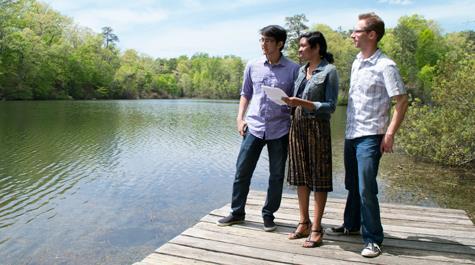Jasmin C. Green '15 is first author on study of Lake Matoaka virus population
Lake Matoaka has a thriving and diverse population of viruses living in its waters. And that’s good.
A paper examining Matoaka’s viral diversity has been published in the journal Aquatic Microbial Ecology. Jasmin C. Green ’15 was the first author on the paper, along with Faraz Rahman ’15, Matthew A. Saxton, a post-doctoral researcher and Kurt E. Williamson, associate professor in the William & Mary Department of Biology.
It’s not uncommon for undergraduate students to be co-authors on a paper, especially at William & Mary. But it’s noteworthy for an undergraduate to be listed as first author on a paper, as Green is on “Metagenomic assessment of viral diversity in Lake Matoaka.”
“To be first author means that you did the lion’s share of the work,” Williamson said, adding that practices that govern the listing of authors varies from discipline to discipline and even from journal to journal. “But in biology, generally speaking, the first author wrote the paper, did the majority of the analysis and may have had a majority share in the idea.”
Green and Rahman have researched viral communities beyond Lake Matoaka. The lake is the former Ludwell’s Millpond, a landmark on the William & Mary campus. The impoundment was created in 1718, making Matoaka one of the oldest man-made lakes in North America.
The two undergraduates formed a research partnership that they called “Jafar,” an appellation they constructing from the beginnings of their first names. Jafar became interested in studying the galaxy of viruses in a class taught by an individual who became a collaborator and co-author on the paper.
“I took a class in microbial ecology and Matt Saxton, the postdoc in Professor Williamson’s lab, was the instructor. He was talking about his research on stormwater retention ponds,” Green said. “That was something I became interested in.”
The paper is likely the first metagenomic study of a small, temperate, eutrophic lake. Williamson explained that “metagenome” refers to the analysis of the genetic makeup of a population of microorganisms, such as bacteria, or in this case, viruses. The work compares the viral population of each of two branches of Lake Matoaka with the main body of the lake.
Jamestown Road runs across the Lake Matoaka dam. A walker standing on the dam, looking straight across the lake, would see the upper lake divided in two by Squirrel Point. To the left is the section of the lake fed by Pogonia Creek; to the right is the section fed by the Crim Dell Creek.
Williamson explained that the Crim Dell inflow drains the landscaped, lived-in and carefully tended William & Mary campus, while Pogonia Creek drains the College Woods, an unmanaged area that sees far less human activity. The idea was to examine the effect of human activity on the viral community by comparing the Pogonia and Crim Dell inflows.
The research included high-tech analysis of viral DNA, but began with simply dipping water out of the lake in strategically selected spots.
“We scoop up two liters of water. We take that back to the lab and filter it,” Rahman said. The filter material is fine enough to let only the viruses pass through, keeping out the comparatively large bacteria and other organisms, he explained. After additional processing, the virus samples are sent out to a lab for sequencing.
“We get the sequencing back, and it’s just a string of letters—A, C, T, G, you know?” Green explained. “Then we match those sequences with online databases and we can start to understand what specific viruses we have here.”
The comparison among the three sites — the mouths of Crim Dell and Pogonia creeks, along with the open water of Lake Matoaka — revealed more than a 90 percent overlap in the types of viruses, but the paper showed a distinct difference in the abundance of the various viruses between portions of the lake fed by Crim Dell and Pogonia. Williamson said the results suggest that anthropogenic land-use practices can decrease the overall richness of species — even among viruses. He noted that many other studies have recorded the effects of human impact on species richness in populations of various animals, including bacteria, but this study is the first to point that the impacts could also extend to the viral population.
As anticipated, the sequence results showed that most of the sample consisted of various bacteriophages — viruses that infect bacteria. Another expected finding is that most of the viruses taken from Lake Matoaka were not represented in the online databases.
“Of the viruses we have sequenced, only about 20 percent matches to something that has been characterized,” Green said.
The paper compares the viral metagenome of Lake Matoaka with those found in a number of systems, including desert ponds known as gueltas, a lake in Antarctica and other waters that Williamson described as “exotic.” He noted that the results support the notion that viruses can be classified into related genetic groups according to their ecosystem of origin.
“Viruses from Lake Matoaka are more genetically similar to viruses from other freshwaters, as far afield as Southern California and France, than to viruses from marine, hypersaline and animal-associated environments,” he said.
















